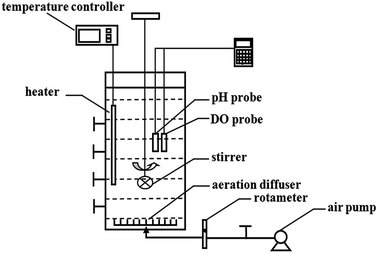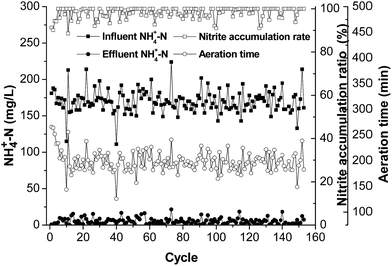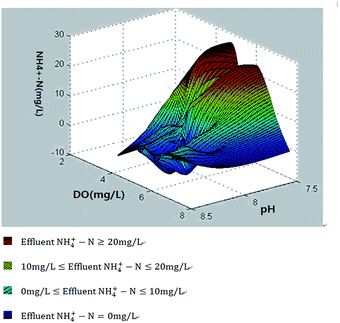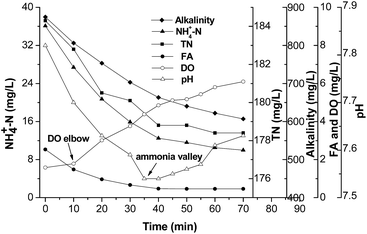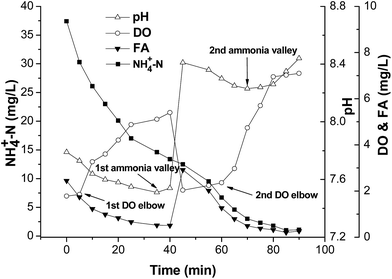Optimization of the real-time control strategy in petroleum-refining catalyst production wastewater treatment with shortcut nitrification†
Tianqi Maa,
Shaohui Guoab,
Zhihui Guob,
Qiushi Zhuc and
Jinfu Chen*a
aState Key Laboratory of Heavy Oil Processing, China University of Petroleum, Beijing 102249, P.R. China. E-mail: cjfcup@126.com; Tel: +86 10 8973 2306
bBeijing Key Laboratory of Oil and Gas Pollution Control Department of Environmental Engineering, China University of Petroleum, Beijing 102200, P.R. China
cCollege of Chemistry and Materials Science, Huaibei Normal University, Anhui 235000, P.R. China
First published on 7th October 2015
Abstract
The characteristics of petroleum-refining catalyst production wastewater are high salinity, high ammonia concentration, and very low C/N ratio. When wastewater is treated with shortcut nitrification in a sequencing batch reactor, only nine cycles are required to reach a nitrite accumulation ratio (NAR) of 85.1%. A high NH4+–N removal efficiency and steady NAR are achieved in the subsequent stable operation stage. However, the DO and pH break points do not always represent the end of ammonia oxidization. In this study, experiments were conducted to determine why break points appear on DO and pH curves. Results show that second break points appear and that pH is a more credible control parameter than DO is. From the start-up and steady running period, a pH controlled at 8.0 to 8.3 is found to be most conducive for nitrite accumulation, and the effluent quality is better than that involving treatment in a low pH condition.
1. Introduction
After conventional nitrification, denitrification is conducted only when enough organic carbon sources exist in wastewater; therefore, an adequate external carbon source is needed, and the costs rise significantly during operation in low C/N ratio wastewater treatment.1,2 Shortcut nitrification and denitrification have shown better performance than the conventional biological nitrogen removal (BNR) process in saving energy and carbon sources and have become research hotspots in the BNR field.3,4While wastewater that contains NH4+–N is treated by shortcut nitrification, the aeration amount should be controlled because excessive aeration not only wastes energy but also promotes the growth of nitrite oxidizing bacteria (NOB). Furthermore, a change in nitrification modes from shortcut to full occurs. A shortcut nitrification study on soybean wastewater treatment showed that the nitrite accumulation ratio (NAR) decreased from 96% to 29% after an extended aeration for 13 cycles.4 The evolution of real-time monitoring parameters, such as pH, dissolved oxygen (DO), oxidation reduction potential (ORP), oxygen uptake rate, and hydrogen ion production rate,5–8 showed some break points that indicate the end of shortcut nitrification. Excessive aeration can be avoided and an improved effluent quality can be obtained if the air pump is shut down when these break points have been observed. In recent years, an online control strategy has been used to maintain and stabilize shortcut nitrification.
No consistent conclusion has been reached on why break points appear. Some studies suggest that ammonia is completely oxidized to nitrite while break points appear.9,10 The data in other studies show that the NH4+–N concentration is still high while break points appear, and the appearance of these break points only represents the terminal point of ammonia oxidization.11,12 The break points on DO and pH curves are more credible than other break points, such as OUR and ORP, and these points symbolize the end of shortcut nitrification. With sufficient alkalinity, an ammonia valley, which occurs at the end of the aerobic phase, is a minimum point in the pH that corresponds to the end of ammonia oxidation.13 A sudden increase in the DO curve, which is called a DO elbow, is also contextually observable on the DO curve at the same time. However, pH as a real-time control parameter has been considered more reliable than DO.14
A high salt concentration (more than 1%) in wastewater adversely affects BNR because of high osmotic pressure15 and causes plasmolysis and loss of biological activity during salinity wastewater treatment.16 Ammonium salt is used in the petroleum-refining catalyst production process, which does not involve organic compounds. Wastewater with high salinity, high ammonia, and low C/N ratio is generated.17 Generally, the optimal pH range should be controlled at 7.0 to 8.5 during shortcut nitrification.18 Sun et al. stated that a high pH leads to a high free ammonia (FA) content in wastewater,19 and nitrite accumulates through NOB inhibition in a high FA environment. A recent landfill leachate treatment research indicated that a constant pH benefits both NAR and the ammonia removal rate compared with an unsteady pH.20 Consequently, the optimum pH range should also be studied in the shortcut nitrification of high-salinity wastewater with a low C/N ratio.
This study aims to achieve the following:
(1) Explore the optimum pH range of petroleum-refining catalyst production wastewater (PRCPW) treatment by shortcut nitrification;
(2) Discuss the relationship between break points and effluent NH4+–N, determine why break points on DO and pH profiles appear, and explain why pH as a control parameter is more credible than DO.
2. Materials and methods
2.1. Characteristics of PRCPW
The NH4+–N concentration in raw PRCPW was more than 1000 mg L−1. After the stream stripping process, the characteristics in PRCPW are as shown in Table 1. The NH4+–N concentration strongly fluctuated, and the C/N (BOD/NH4+–N) ratio in PRCPW was less than 0.4. A large number of aluminosilicates and synthetic zeolites that come from catalyst production processes can be found in wastewater, and they also significantly contribute to the salt content. The conductivity in wastewater was 10.8 ms cm−1 to 22.6 ms cm−1, which is approximately an equivalent amount of 8 g L−1 to 17 g L−1 sodium chloride.| T (°C) | pH | COD (mg L−1) | BOD (mg L−1) | NH4+–N (mg L−1) | Conductivity (ms cm−1) | |
|---|---|---|---|---|---|---|
| Range | 28.4–34 | 6.7–8.3 | 75–290 | 36–64 | 75.1–291.5 | 10.8–22.6 |
| Average | 30.8 | 7.3 | 190 | 51 | 169.3 | 16.3 |
2.2. Lab-scale experiment reactor
The experiment was conducted in a 5 L lab-scale sequencing batch reactor (SBR), with an internal diameter of 12 cm and a liquid height of 50 cm. Air was provided by an air pump through an aeration diffuser placed at the bottom of the reactor. The DO concentration was controlled at 1.5 ± 0.2 mg L−1, the SRT was 15 to 20 days and the temperature provided by a cartridge heater was stable at 30 ± 2 °C, and the pH was regulated by addition of Na2CO3. The DO and pH were continuously monitored and recorded every 5 minutes during the aeration period.2.3. Analytical methods
Conductivity (salt concentration) was determined with the Leici DDSJ-308F conductance meter, China.The DO and pH were determined with WTW pH/OXi 340i meters, Germany.
Analyses of NH4+–N, NO2−–N, NO3−–N, TN, and alkalinity were performed with the use of standard methods.21
2.4. Math formulae
NAR (%) was obtained by comparison of the concentrations of NO2−–N and NO3−–N in the effluent of shortcut nitrification:
 | (1) |
FA (mg L−1) was estimated with the following equation:22
 | (2) |
AUR (kgNH4+–N m−3 d−1) is the ammonia uptake rate, which was represents the ammonia oxidation rate in unit time and physical volume. AUR could be calculated from concentrations of NH4+–N at two time points:
 | (3) |
2.5. SBR experiment
Sludge (4000 mg L−1) obtained from the activated sludge tank of a PRCPW treatment plant in Lanzhou, Gansu Province, China was seeded into the 5 L SBR reactors. The operation procedure in a cycle was inflow (10 minutes), aeration, settling (20 minutes) and effluent discharging (20 minutes), so there was no denitrification period in a cycle. In the aeration period, the length of aeration time depends on the moment that the DO elbow and the ammonia valley appeared. Besides, if no break point or only one break point was observed, stop the air supply by a maximum time of 6 hours.The SBR operation was divided into two stages, the start-up stage (19 cycles in total) and the stable operation stage (153 cycles).
In the start-up stage, 3 reactors of the same type as those introduced in Fig. 1 were prepared in parallel in response to the needs of studies at different pH conditions.
In the stable operation stage, the reactor which performed best in the start-up stage was used in the stable operation period.
3. Results and discussion
3.1. Start-up of shortcut nitrification
The pH range was controlled at 7.5 to 8.0 (reactor #1), 7.8 to 8.3 (reactor #2), and 8.0 to 8.5 (reactor #3) separately in three reactors in parallel to obtain the optimum pH range for nitrite accumulation. DO, pH and temperature conditions were consistent with the conditions described in the Section 2.2. NAR in the effluent of the original cycle for each reactor was 40% to 50%, and the changes over cycles are shown in Fig. 2a.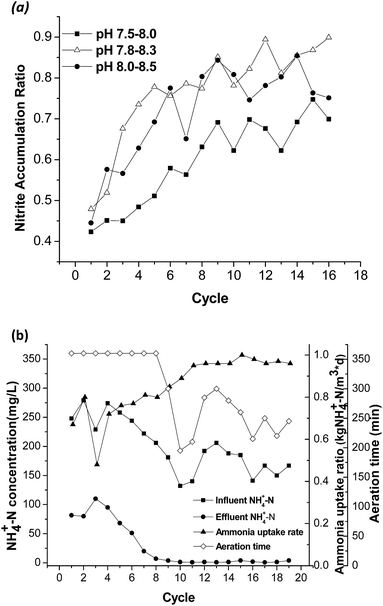 | ||
| Fig. 2 (a) Changes in NAR under different pH ranges in the start-up period and (b) NH4+–N removal performances in the start-up period of reactor #2. | ||
The increase rate of NAR in reactor #1 was the slowest, and the NAR value was just 60% to 70% after 15 cycles. The increase of the NAR value in reactor #2 was the fastest and reached 85.1% in nine cycles. The NAR value then remained steady at a relatively high level of more than 80%. The increase rate of NAR in reactor #3 was between that of reactors #1 and #2. Although the NAR value increased to 80.3% at the eighth cycle, it fluctuated between 70% and 85% in the subsequent cycles.
Table 2 shows the relationship between pH and the average initial free ammonia (IFA) concentration. The FA inhibition threshold values are 10 mg L−1 to 150 mg L−1 for AOB23 and 0.1 mg L−1 to 6.0 mg L−1 for NOB.24 While the pH was controlled at approximately 7.5, a FA less than 6.0 mg L−1 could not completely inhibit NOB activity during the aeration period. When the pH was controlled at 8.3, the IFA concentration was 33.6 mg L−1 in average during the start-up stage, as the minimum FA concentration to inhibit NOB was 10 mg L−1,23 the IFA that exceeds 30 mg L−1 could seriously inhibit the AOB activity, which caused the NAR in reactor #3 increased slower than that in reactor #2. Thus, the pH range past 8.3 was too high for the nitrite accumulation.
| pH | IFA |
|---|---|
| a Calculated on the basis of 200 mg L−1 of initial NH4+–N and 30 °C of temperature. | |
| 7.5 | 6.0 |
| 7.8 | 11.7 |
| 8 | 18.1 |
| 8.3 | 33.6 |
| 8.5 | 49.3 |
Thus, if the pH was controlled at 7.8 to 8.3, AOB had a good activity, and NOB was seriously inhibited. The nitrite accumulation ratio quickly reached more than 85% in 9 cycles, which was much shorter than that in other wastewater treatments.8,20,25
The changes in the removal rate of NH4+–N and ammonia uptake rate (AUR) in reactor #2 are shown in Fig. 2b. During the start-up period, the influent NH4+–N was 132 mg L−1 to 279 mg L−1. The aeration duration in the first seven cycles was controlled at a fixed maximum time of 6 hours. The aeration time in the following cycles was in accordance with break points that appeared on the DO and pH curves, and the aeration time waved between 190 to 300 minutes. As the AUR increased from 0.67 kgNH4+–N m−3 d−1 to 0.80 kgNH4+–N m−3 d−1 to 1.00 kgNH4+–N m−3 d−1, the NH4+–N concentration in the effluent decreased from more than 80 mg L−1 to less than 5 mg L−1. This phenomenon indicated the sudden drop of ammonia effluent concentration was account for not only the drop of influent concentration, but also the raise of AUR.
As shown in Fig. 2b, the raise of AUR caused the aeration time decreased from 6 hours (1st to 8th cycle) to less than 300 min (9th to 19th cycle), as the air supply rate was probably the same in these cycles, compared to conventional nitrification, the air demand decreased and the energy could be saved after shortcut nitrification start-up.
3.2. Stable operation of shortcut nitrification
As the NAR increased most quickly in the start-up stage was the reactor #2, we used the reactor #2 and the sludge of the reactor in the stable operation stage. The initial sludge concentration was 4000 mg L−1 and the pH value was controlled at 7.5 to 8.5 in the stable operation period involving more than 150 cycles. Other conditions were consistent with the conditions described in the Section 2.2. The conductivity of the influent waved between 10.86 ms cm−1 and 19.87 ms cm−1. The air pump was shut down when the break points appeared, so the aeration time was different from cycle to cycle, and the range waved between 126 to 266 min. NH4+–N, NO2−–N, and NO3−–N were detected every cycle. The performance of the stable operation period is shown in Fig. 3.During this stage, the NAR was still higher than 88.5%, which indicated that shortcut nitrification can be stably operated with a real-time control strategy. Shortcut nitrification was more efficient than traditional nitrification in ammonia oxidization. As shown in Fig. 3, after 15 cycles in this stage, the AUR was maintained stable at about 1.2 kgNH4+–N m−3 d−1. In the first several cycles of the star-up period, the AUR was less than 0.8 kgNH4+–N m−3 d−1, the AUR in stable operation stage (about 1.2 kgNH4+–N m−3 d−1) was over 1.5 times of AUR in traditional nitrification treatment.
The average NH4+–N concentrations were 170.0 mg L−1 in the influent and 5.5 mg L−1 in the effluent. The average removal ratio of NH4+–N was 96.9%. However, the NH4+–N concentration in the effluents of 19 cycles (around 12.5%) was higher than 10 mg L−1, and the highest value reached 21 mg L−1. This result means that the DO and pH break points do not always signify the complete oxidization of ammonia and that these points appear early.
3.3. Optimum pH at the terminal point
In the stable operation stage, the values of DO and pH at the terminal point of shortcut nitrification may have a synergistic effect on the effluent NH4+–N concentration. Fig. 4 shows that the higher the pH and DO values that appeared at the end point, the lower was the NH4+–N concentration in the effluent.Performance before and after DO elbow appeared. During the first 10 minutes, the AUR was 1.25 kgNH4+–N m−3 d−1, and it was equivalent to the average value of AUR in normal conditions. At the 10th minute, the NH4+–N concentration was 27.4 mg L−1. Thus, the FA concentration was 1.48 mg L−1, which was significantly below the IFA.
The DO value showed a significant increase and reached 3.01 mg L−1 at the 20th minute, a result indicating the appearance of the DO elbow. From the 10th to the 20th minutes, the AUR decreased to 0.96 kgNH4+–N m−3 d−1. During the 20th to 30th and 30th to 40th minutes, the AUR values were 0.69 and 0.49 kgNH4+–N m−3 d−1, respectively. Indicated that the ammonia oxidation didn't end after DO elbow appeared.
Appearance reason of DO elbow. The NH4+–N concentration was still high when the DO elbow appeared, and the ammonia oxidation process did not stop. Because the major substrate of AOB is FA but not NH4+ ion,26 the effect of FA on DO elbow needs to be discussed. Fig. 5 shows an obvious decreasing trend on FA removal rate, indicated that the appearance of the DO elbow is caused by the low FA concentration in the reactor, which was inadequate in supplying all the nitrifying bacteria to give full play to their activity. Under a stable amount of aeration, the surplus aeration quantity generated was increased, and the DO elbow appeared. This result showed while FA concentration was decreased to a certain value, the AUR began to decrease sharply. Then, DO elbow was occurred because of the sharp decrease of AUR.
Performance before and after ammonia valley appeared. An ammonia valley was observed at the 35th to 40th minutes. At the 40th minute, the NH4+–N concentration was still as high as 12.5 mg L−1. During the 40th to 70th minutes, the AUR decreased to the range of 0.07 kgNH4+–N m−3 d−1 to 0.16 kgNH4+–N m−3 d−1, showed that ammonia oxidation still existed after the appearance of ammonia valley, though the AUR was decreased to a very low value.
Meanwhile, the FA was maintained at approximately 0.45 mg L−1. This result indicated that after the FA decreased to a certain value, it remained unchanged. It was the FA converted from NH4+ as the pH increased almost fully accounted for the AUR.
Appearance reason of ammonia valley. In the stable operation period, with the low DO of 1.5 ± 0.2 mg L−1, denitrification process occurred simultaneous with the ammonia oxidation, and about 10% to 15% of total nitrogen was removed. So ammonia oxidation, nitrite reduction, and CO2 stripping (by air) could exist simultaneously in the reactor, these processes can cause alkalinity changes and thus affect the pH value. The reaction equations are described as follows:
Ammonia oxidation:
 | (4) |
Nitrite reduction:
 | (5) |
CO2 stripping:
 | (6) |
The alkalinity consumed by ammonia oxidation can be calculated by the decreased amount of NH4+–N for a particular period:
 | (7) |
The alkalinity generated by nitrite reduction can be calculated by the decreased amount of total nitrogen (TN) for a particular period:
| AGNR = 3.57 × (TNt1 − TNt2) | (8) |
The decreased amount of total alkalinity (DATA) can be determined with the use of standard methods. Thus, the alkalinity consumed by CO2 stripping (ACCS) can be calculated as follows:
| ACCS = DATA + AGNR − ACAO | (9) |
Eqn (3)–(5) show that ammonia oxidation decreases the alkalinity and pH, nitrite reduction increases the alkalinity and pH, and CO2 stripping decreases the alkalinity and increases the pH. The proportional relation of the mole between alkalinity and H+ is 1![[thin space (1/6-em)]](https://www.rsc.org/images/entities/char_2009.gif) :
:![[thin space (1/6-em)]](https://www.rsc.org/images/entities/char_2009.gif) 2.27 Thus, the change in pH in the three processes can account for the variation in alkalinity.
2.27 Thus, the change in pH in the three processes can account for the variation in alkalinity.
In a certain period, if ACAO > AGNR + ACCS, that is, the H+ generated by ammonia oxidation is higher than the sum of the H+ consumed by nitrite reduction and CO2 stripping, the pH curve shows a decreasing trend.
By contrast, if ACAO = AGNR + ACCS, the pH curve remains stable at a certain value.
If ACAO < AGNR + ACCS, the pH value increases.
This condition shows that no other reactions affect the change in pH.
The changes in alkalinity every 10 minutes caused by ammonia oxidation, nitrite reduction, and CO2 stripping from NH4+–N, TN, and the total alkalinity values are depicted in Fig. 5 and shown in Table 3. The ACAO value was obviously much more than the sum of ACCS and AGNR at the 10th to 30th minutes. The pH curve showed a decreasing trend. When the ACAO sharply decreased to 24.1 mg L−1, the value was almost the same as the sum of ACCS and AGNR (25.1 mg L−1). A plateau was found at the 35th to 40th minutes. Although nitrite reduction was almost stopped because of the high DO in the reactor at the 40th to 60th minutes, the sharp decrease in ammonia oxidation resulted in the ACAO becoming much less than the ACCS and led to an increasing trend in the pH curve.
| Time (min) | DATA | AGNR | ACAO | ACCS |
|---|---|---|---|---|
| 10–20 | 52.7 | 8.2 | 47.4 | 13.5 |
| 20–30 | 50.1 | 1.4 | 33.9 | 17.6 |
| 30–40 | 40 | 4.6 | 24.1 | 20.5 |
| 40–50 | 23 | 0 | 6.3 | 16.7 |
| 50–60 | 18.1 | 1.4 | 7.9 | 11.6 |
The experimental data were consistent with the prediction, a result indicating that the appearance of the ammonia valley was a result of interactions among ammonia oxidation, nitrite reduction, and CO2 stripping.
During more than 150 cycles of operation, the FA concentration level when the DO elbow can be observed was approximately 1.4 mg L−1 to 2.1 mg L−1. The break points on the pH curve appeared at 0.3 mg L−1 to 0.6 mg L−1 of FA. Thus, for instance, while pH in reactor was controlled at about 7.6, when the DO elbow appeared, the NH4+–N concentration can reach 30 mg L−1 to 45 mg L−1. If the initial NH4+–N of the wastewater was less than 30 mg L−1, observing the appearance of the DO elbow may be difficult. However, if the ammonia valley appeared while the pH was 7.6, NH4+–N was generally approximately 6.5 mg L−1 to 13 mg L−1. The possibility that the ammonia valley has not appeared on the pH curve is much lower than the same possibility with the DO elbow. This reason explains why the DO elbow is sometimes unreliable compared with the ammonia valley, especially in weak nitrogenous wastewater treatment.28
This study proved that pH break points can be controlled at a range that improves the removal ratio of NH4+–N. Fig. 4 shows that if the pH is controlled at more than 8.0, the NH4+–N concentration in the effluent should be less than 10 mg L−1 when the ammonia valley appears. With the optimum pH range of the start-up period considered, the pH should be controlled at 8.0 to 8.3 before the appearance of break points.
4. Conclusions
In this paper, the start-up experiments indicate that the optimal pH range for nitrite accumulation is 7.8 to 8.3. However, the second break point phenomenon demonstrates that under a constant temperature condition, a relatively high pH at the terminal point rather than other conditions during aeration stage could benefits the NH4+–N removal ratio. Thus, when treating PRCPW with shortcut nitrification, the pH should be maintained at 8.0 to 8.3.Unlike results from other studies, the appearance of break points in this study could represents neither the complete oxidation of NH4+–N, nor the terminal of ammonia oxidation. Based on this discovery, by experiment, we found that the DO elbow was caused by the sharp decrease of AUR, and the ammonia valley was caused by the interactions among ammonia oxidation, nitrite reduction, and CO2 stripping. In this study, the FA concentration value when the DO elbow can be observed was approximately 1.4 mg L−1 to 2.1 mg L−1, and the ammonia valley appeared from 0.3 mg L−1 to 0.6 mg L−1 of FA. So the reason for pH being more credible as a control parameter than DO was also determined.
To shortcut nitrification with real-time control strategy, this paper may provide some references on accuracy control.
Abbreviations
| ACAO | Alkalinity consumed by ammonia oxidation (mg L−1) |
| ACCS | Alkalinity consumed by CO2 stripping (mg L−1) |
| AGNR | Alkalinity generated by nitrite reduction (mg L−1) |
| AOB | Ammonia oxidizing bacteria |
| AUR | Ammonia uptake rate (kgNH4+–N m−3 d−1) |
| DATA | Decreased amount of total alkalinity (mg L−1) |
| FA | Free ammonia (mg L−1) |
| IFA | Initial free ammonia (mg L−1) |
| NAR | Nitrite accumulation ratio (%) |
| NOB | Nitrite oxidizing bacteria |
| PRCPW | Petroleum-refining catalyst production wastewater |
| SRT | Sludge retention time (d) |
Notes and references
- L. M. C. Daniel, E. Pozzi, E. Foresti and F. A. Chinalia, Bioresour. Technol., 2009, 100, 1100–1107 CrossRef CAS PubMed.
- G. Ruiz, D. Jeison and R. Chamy, Water Res., 2003, 37, 1371–1377 CrossRef CAS.
- G. Ciudad, O. Rubilar, P. Mu Oz, G. Ruiz, R. Chamy, C. Vergara and D. Jeison, Process Biochem., 2005, 40, 1715–1719 CrossRef CAS PubMed.
- D. Gao, Y. Peng, B. Li and H. Liang, Bioresour. Technol., 2009, 100, 2298–2300 CrossRef CAS PubMed.
- J. B. Holman and D. G. Wareham, J. Environ. Eng., 2003, 129, 52–58 CrossRef CAS.
- S. Puig, L. Corominas, M. T. Vives, M. D. Balaguer, J. Colprim and J. Colomer, Ind. Eng. Chem. Res., 2005, 44, 3367–3373 CrossRef CAS.
- R. Blackburne, Z. Q. Yuan and J. Keller, Water Res., 2008, 42, 2166–2176 CrossRef CAS PubMed.
- X. Zhang, D. Zhang, Q. He, H. Ai and P. Lu, Environ. Technol., 2014, 35, 1478–1483 CrossRef CAS PubMed.
- Y. Liu, B. Tang, K. F. Zhao, M. Pijuan and Y. Z. Peng, 10th IWA conference on Instrumentation, Control & Automatation, Cairns, 2009 Search PubMed.
- P. Tanwar, T. Nandy, P. Wkey and P. manekar, Environ. Technol., 2008, 99, 7630–7635 CAS.
- T. Bai, H. Lei, G. Yu, Q. Yu, Z. Li and H. Li, Process Saf. Environ. Prot., 2009, 87, 307–314 CrossRef CAS PubMed.
- H. Sun, Y. Peng, S. Wong and J. Ma, J. Environ. Sci., 2015, 30, 157–163 CrossRef PubMed.
- G. Andreottola, P. Foladori and M. Ragazzi, Water Sci. Technol., 2001, 43, 93–100 CAS.
- C. Antileo, H. Medina, C. Bornhardt, C. Mu Oz, F. Jaramillo and J. Proal, Chem. Eng. J., 2013, 223, 467–478 CrossRef CAS PubMed.
- T. Panswad and C. Anan, Water Res., 1999, 33, 1165–1172 CrossRef CAS.
- F. Kargi and A. R. Dincer, Enzyme Microb. Technol., 1996, 19, 529–537 CrossRef CAS.
- X. Zhao, Q. Hu, Y. Chen, W. Hu, G. Zhou, Q. Yuan and D. Gao, Chin. J. Environ. Eng., 2014, 8, 1951–1995 CAS.
- J. Groeneweg, B. Sellner and W. Tappe, Water Res., 1994, 28, 2561–2566 CrossRef.
- S. Sun, P. N. Carles, B. Merkey, Q. Zhou, S. Xia, D. Yang, J. Sun and F. S. Barth, Environ. Eng. Sci., 2010, 27, 111–126 CrossRef.
- C. Zhang, S. Zhang, L. Zhang, H. Rong and K. Zhang, Appl. Microbiol. Biotechnol., 2015, 99, 3707–3713 CrossRef CAS PubMed.
- APHA, Standard Methods for the Examination of Water and Wastewater, American Public Health Association/American Water Works Association/Water Environment Federation, Washington, D.C., USA, 20th edn, 1998 Search PubMed.
- A. C. Anthonisen, R. C. Loehr, T. B. S. Prakasam and E. G. Srinath, J.–Water Pollut. Control Fed., 1976, 48, 835–852 CAS.
- J. E. Alleman, Water Sci. Technol., 1984, 17, 409–419 Search PubMed.
- V. M. Vadivelu, J. Keller and Z. Yuan, Water Sci. Technol., 2008, 56, 89–97 CrossRef PubMed.
- G. Lu, P. Zheng, P. Jin and M. Qaisar, J. Environ. Sci., 2006, 18, 58–61 CAS.
- B. B. Ward, D. J. Arp and M. G. Klotz, Nitrification, IWA publishing, London, 2011, p. 15 Search PubMed.
- M. Henze, M. C. M. Van Loosdrecht, G. A. Ekama and D. Brdjanovic, Biological wastewater treatment: Principles, Modelling and Design, London, IWA publishing, 2008, pp. 112–139 Search PubMed.
- J. Guo, Y. Peng, S. Wang, H. Huang and Z. Wang, Bioresour. Technol., 2009, 100, 2796–2802 CrossRef CAS PubMed.
Footnote |
| † Electronic supplementary information (ESI) available. See DOI: 10.1039/c5ra14611a |
| This journal is © The Royal Society of Chemistry 2015 |

